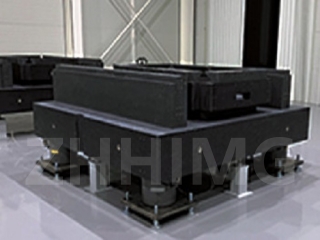In recent years, computed tomography (CT) technology has become increasingly important in many industrial manufacturing processes. CT scanning not only provides high resolution images but also enables non-destructive testing and analysis of samples. However, one of the most significant challenges facing the industry is the need for stable and accurate scanning platforms. The Granite machine base is one of the prime options for this purpose.
Granite machine bases are made up of granite slabs, which are machined to form a stable and flat surface. These bases offer good stability, vibration damping, and dimensional stability, all of which are essential features for accurate CT imaging. Granite has been used in the manufacturing and scientific industries for many years due to its exceptional physical properties. These properties make it ideal for precision measurement applications.
Here are some steps to use the granite machine base for industrial CT scanning:
Step 1: Calibrate the CT system
Before using the granite machine base, the CT system must be calibrated. Calibration involves setting up the CT scanner and verifying that the scanner is operating within its specifications. This step ensures that the CT scanner can provide reliable and accurate data.
Step 2: Choose a suitable granite machine base
It's essential to choose a granite machine base that fits the size and weight of the scanner and your sample material. Granite machine bases come in different sizes, depending on the type of application you need. It's imperative to choose the right size to ensure that the sample material is adequately supported, and the CT scanner produces accurate output.
Step 3: Mount the CT scanner on the granite machine base
When mounting the CT scanner onto the granite machine base, it's essential to ensure that the machine base is level. Leveling the granite machine base will provide a stable scanning platform, which is essential for accurate imaging. Also, ensure that the scanner is mounted securely to the machine base for optimal stabilization.
Step 4: Prepare the sample
Prepare the sample material for CT scanning. This step includes, cleaning, drying, and positioning the object on the granite machine base. Positioning the sample material is crucial and should ensure that the object is in the correct position for imaging and is held securely to prevent movement that could affect the accuracy.
Step 5: Conduct the CT scan
After preparing the sample, it's time to conduct the CT scan. The CT scanning process involves rotating the sample while radiating it with x-rays. The CT scanner collects data, which is processed to produce 3D images. The stability and accuracy of the granite machine base play a vital role in the quality of the final output.
In summary, CT scanning has become critical in many industries, and a stable, precise scanning platform is essential for accurate imaging. The granite machine base provides the perfect solution and enhances the accuracy of the CT scanner results. Its vibration damping, stability, and dimensional stability make it the ideal choice for CT scanning applications. With proper calibration and mounting, the granite machine base offers exceptional support for any industrial CT scanning application.
Post time: Dec-19-2023

